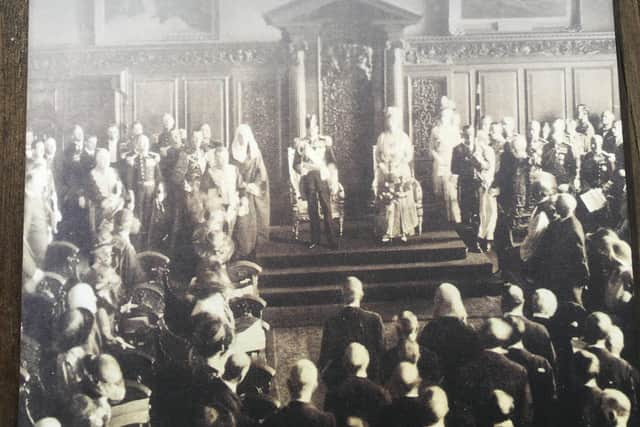NI Protocol: Historian’s warning from 1921 about instability and violence in 2021
and live on Freeview channel 276
A historian who has just published a new book detailing violence at the birth of Northern Ireland has warned of the possibility of history repeating itself if political stability is allowed to fester in 1921.
A Belfast native, Dr Alan Parkinson is a former university history lecturer, an historian and author who has spent most of his career in London but whose heart has remained here, penning a long list of books on Irish history.
Advertisement
Hide AdAdvertisement
Hide AdHis latest book, A Difficult Birth, The Early Years of Northern Ireland 1920-25, looks at the political instability and associated violence associated with the birth of the state.


“The central theme going through the book is the correlation between imminent political change and community instability - a theme that is constantly in our history,”
Looking across the myriad factors impacting on Northern Ireland at present, in particular the Irish Sea Border and related issues, he says there are many parallels to the 1920s.
“Some people would say 2021 - with the border in the Irish sea community - tension is rising over political instability. If the assembly falls, that is another.”
Advertisement
Hide AdAdvertisement
Hide AdHe accepts that is not unusual in Irish politics but that despite it being our ‘normal’, it is not a given in other countries.


“That is what a lot of people are afraid of.”
“The key thing about 1920-22 is that it got so bad because of the fact that partition and a new parliament in Belfast was looming. It just got out of hand completely and you had the manifestations of violence which we have seen in more recent conflicts, the sectarian name calling, chucking bottles and stones followed by gunfire and bombs and so on.”
The violence happened right across Belfast but especially in the west and north in mixed areas as well as outlying areas of the Province.
“Over 100 people died - some 40-50 of them policemen - in the rural areas and in parts of the north west. There were attacks on police officers all over the place.”
Advertisement
Hide AdAdvertisement
Hide AdIn Cushendall a number of Catholics were shot, and in Altnaveigh, a little protestant area just outside Newry, six Protestants were murdered by the IRA. There were a number of shootings of police right along the border areas.”
In 1921 the backdrop was the legislation being passed in Westminster for Parliaments in Belfast and Dublin, which was rejected by Sinn Fein in the south.
A lot of the violence was “tit for tat”.
Paramilitary groups were responsible for most of the murders, the IRA’s third northern division who operated mainly in Belfast but had divisions across Ulster and the Ulster Protestant Association.
“Then you also had some rogue cops who retaliated because their colleagues had been shot and they sometimes took it out on Catholics in their own areas.”
Advertisement
Hide AdAdvertisement
Hide Ad“The typical kind of killings would have been on tram cars, as people travelled home from work.The IRA would bomb trams cars and killed quite a few people that way.The UPA would shoot Catholics on tram cars. Two poor guys were shot dead because they were crossing themselves as they passed a chapel in north Belfast.”
If two policemen were murdered UPA members were probably told to go out and kill a couple of Catholics, he adds.
“The IRA were more formal and structured as in the more modern conflict but equally guilty of cold sectarian shootings too. For instance they went into a barrel factory in Belfast and told Protestants to line up on one side and Catholics on the other and they shot the four Protestants.”
And what lessons have we not learned in 100 years?
“The lesson for us today is looking back on this time, is that those people determined to take life feed off instability and this is what happened particularly in 1920. Because you had the uncertainty over the new parliament, which unionists were not initially keen on, though [Prime Minister] James Craig persuaded them to support - and which nationalists were completely opposed to.
Advertisement
Hide AdAdvertisement
Hide Ad“And because political tension was so high it meant that the godfathers of violence were able to capitalise on that. And I suppose that is the danger in today’s situation with regards the Irish Sea Border and so on. People who are more interested in violent solutions come to the fore a lot more.
“There is the possibility that if we let the political instability fester there is the greater potential of violence. If we don’t do something about the political instability then there is the pronounced danger that we could return to violence - I think a lot of people would agree.”
The south - The Irish Free state as it became known initially - was very much opposed to partition, he notes in the book.
“They were also annoyed by the treatment of Catholics in Belfast forced out of their jobs and homes.So they instituted a trade boycott which meant that merchandise which was going to the north was hijacked by armed IRA men and the goods destroyed or turned back and the banks with Ulster currency were boycotted.”
Advertisement
Hide AdAdvertisement
Hide AdSinn Fein was the predominant party in the fledgling state at the time and the IRA was a paramilitary organisation - and later became a state force.
“Loyalists had a counter boycott with mixed success - on goods coming from the south into the north by the Ulster Trade Defence Association - it was quite funny because they also tried to stop people in Belfast drinking Guinness.”
With leading political figures here variously warning of either republican or loyalist violence in relation to an EU customs border, he says there are “lots of interesting comparisons there” today.
Quite a lot more Catholics than protestants died - Belfast was about two thirds Protestant and yet two thirds of the fatalities were Catholics.
Advertisement
Hide AdAdvertisement
Hide Ad“So basically twice as many Catholics died as Protestants in the violence particularly in Belfast.”
However he rejects any suggestion it was a pogrom and notes that many Protestant owned businesses, as well as schools and cinemas were burned to the ground.
“The old saying is that history repeats itself - it certainly does as far as Northern Ireland is concerned.
“I do talk in the book about the violence in the rest of Ireland at that time.”
Advertisement
Hide AdAdvertisement
Hide AdHe believes much of the violence in Irish history is due to fear of oppression or extermination by the other side.
“That is right. Most people in the north - it was in the pages of all the loyalist newspapers - were only too aware of the deaths of serving police officers in the south - many of them from Ulster.
“What was happening in the rest of Ireland was actually impacting directly on them in Ulster even though it was far away.
“The importance of this historical context is great. I do try to make that clear in the book.”
Advertisement
Hide AdAdvertisement
Hide AdBut factors north and south would leach away the strength of the violence, at least for a time.
The outbreak of civil war in the summer of 1922 in the south and Prime Minister James Craig introducing special powers legislation and internment ended the violence in Ulster at that time.
“The IRA were basically beaten because any of them who were still around who had not been interned went to fight in the civil war for one side or the other. And the south lost interest in the north because they had their own war to focus on. So what happened in the south had a massive impact on what happened in the north both before the Trouble in the north broke out - and even after it ended.”
:: A Difficult Birth, The Early Years of Northern Ireland 1920-25 is available from Waterstones, online and from publisher Eastwood Books Dublin, price £21.95.
MORE NEWS:
Advertisement
Hide AdAdvertisement
Hide AdAdvertisement
Hide AdAdvertisement
Hide AdA message from the Editor:
Thank you for reading this story on our website. While I have your attention, I also have an important request to make of you.
With the coronavirus lockdown having a major impact on many of our advertisers - and consequently the revenue we receive - we are more reliant than ever on you taking out a digital subscription.
Subscribe to newsletter.co.uk and enjoy unlimited access to the best Northern Ireland and UK news and information online and on our app. With a digital subscription, you can read more than 5 articles, see fewer ads, enjoy faster load times, and get access to exclusive newsletters and content. Visit https://www.newsletter.co.uk/subscriptions now to sign up.
Advertisement
Hide AdAdvertisement
Hide AdOur journalism costs money and we rely on advertising, print and digital revenues to help to support them. By supporting us, we are able to support you in providing trusted, fact-checked content for this website.
Alistair Bushe
Editor